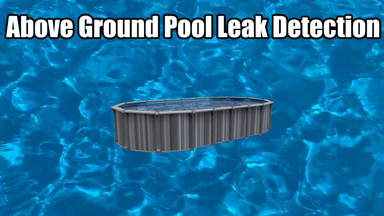Published by EZ Pool & Spa Supply on 05/15/2017
Finding a Leak in an Above Ground Pool (Part 1 of 2)
Even a minor leak in a pool is more than just an irritating nuisance. Losing water in an above ground pool will cost you a bundle even in the semi-long term, and may even pose a threat to the entire pool’s structure as well. Large leaks, especially in the liner, are often readily visible, making it easy to spot and relatively easy to repair. Small leaks, though easy to fix, can feel near impossible to locate. So how do you find a leak in an above ground pool? Are there ways to track down and repair pool leaks? Yes there are. It might take a little time but there are some tricks that can help you find and fix leaks.
Let’s start off by saying that even a minor water leak can have some serious negative effects on the pool and may be draining your wallet as well! It’s easy to think of this as simply taking out the garden hose every week or so to top off the pool, but there’s much more that you’re losing than a few inches of water. The cost of topping off the pool regularly adds up little by little in the form of a larger than normal water bill, or electric bill if you are on a well. Because you need to add more water consistently, you continue to dilute and diminish the pool chemicals you’ve added already, by topping off with chemically untreated water. You lose water, but you also lose the pool chemicals that have been added!
On a more serious note, if you have a leak in the pool liner you could be enabling the shortening of your pool’s lifespan – or the liner itself. A good quality pool will be made from steel that has been galvanized, made with alloy materials, and treated with several layers of primer, paint and clear coat finishes. This makes for a rust-free pool for years to come. But take even a small pinhole in the sidewall of the liner, and the long term effects of chlorinated water constantly flowing in the same spot (and trapping a lot of moisture between the wall and liner) and you will greatly accelerate the rusting of the pool. If ignored, this can cut the life of the pool in half!
A leak can also have the effect of eroding the stone dust or sand base place on the inside of the pool wall just under the liner, known as the cove. Erosion of this cove may lead to premature liner failure. And in the most extreme cases, a leak left unfixed when the pool is closed for the winter very well can lead to a pool being destroyed beyond repair. Picture this – the winter cover, held on tightly by a steel cable and winch that holds up literally tons of water, ice and snow places undue stress on the frame and wall because the cover is no longer supported by the water under the cover. It has drained out or way down! This load on the cover now pulls the frame and wall down and inward destroying the whole pool. My advice is if you have a leak, DO NOT CLOSE YOUR POOL UNTIL YOU FIND THE LEAK, REPAIR IT, AND MAKE SURE IT DOES NOT CONTINUE TO LEAK!!!!! Are you starting to see the potential cost of a MINOR LEAK? Not so minor anymore, huh?
OK, so let’s talk about finding these leaks and how to fix them. In general, I will tell my customers that if they have had a pool for a few years and they suspect they have a leak, they probably do. Trust your instincts a little! A leak will either be in the liner (which most of the time can be patched easily) or in the skimmer, return fittings, pump, filter and associated hoses. If you want to confirm that you have a leak and it is not evaporation, start with the “bucket test”.
The Bucket Test
It’s this simple – put a bucket (that doesn’t leak!) on the top of your pool’s stairs or ladder rung inside of your pool and fill it so that the level of the water in the bucket is up to the equal height of the pool’s water level. Mark the level on the inside and outside of the bucket with a permanent marker. Leave the bucket alone for anywhere between 3 to 7 days and do not top off the water, checking regularly to look for a change. If you have a leak anywhere in the pool, the water level inside the bucket will be at a level higher than that of the pool’s water. If both levels have dropped equally you simply have evaporation – this test is most effectively done when temperatures are cooler at the beginning or end of the season. Even though the two bodies of water (the pool and the bucket) are vastly different in size, the rate of evaporation will be consistent.
So now you’ve hopefully confirmed whether or not you truly have a leak in your pool. Next week we’ll talk about what to do if you have a leak, how to pinpoint the location and how to repair that leak. Don’t lose heart…keep swimming!
If you have any more questions, your friends at E-Z Test Pools would be more than happy to assist you! Visit us in-store or online today to learn more!







